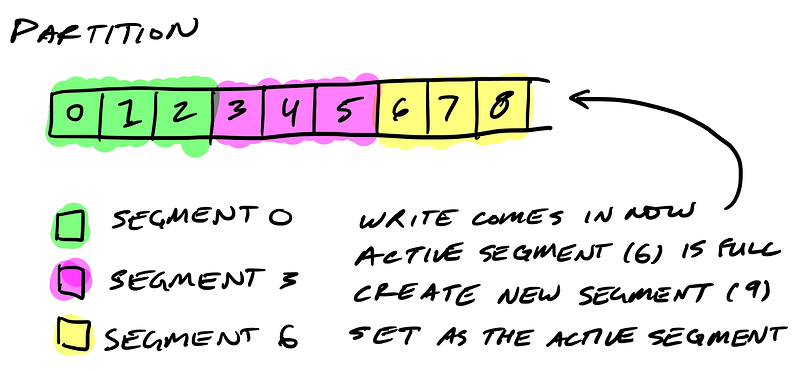How Kafka’s Storage Internals Work
In this post I’m going to help you understand how Kafka stores its data.
I’ve found understanding this useful when tuning Kafka’s performance and for context on what each broker configuration actually does. I was inspired by Kafka’s simplicity and used what I learned to start implementing Kafka in Golang.
So how does Kafka’s storage internals work?
Kafka’s storage unit is a partition
A partition is an ordered, immutable sequence of messages that are appended to. A partition cannot be split across multiple brokers or even multiple disks.

The retention policy governs how Kafka retains messages
You specify how much data or how long data should be retained, after which Kafka purges messages in-order—regardless of whether the message has been consumed.
Partitions are split into segments
So Kafka needs to regularly find the messages on disk that need purged. With a single very long file of a partition’s messages, this operation is slow and error prone. To fix that (and other problems we’ll see), the partition is split into segments.
When Kafka writes to a partition, it writes to a segment — the active segment. If the segment’s size limit is reached, a new segment is opened and that becomes the new active segment.
Segments are named by their base offset. The base offset of a segment is an offset greater than offsets in previous segments and less than or equal to offsets in that segment.

On disk a partition is a directory and each segment is an index file and a log file.
$ tree kafka | head -n 6
kafka
├── events-1
│ ├── 00000000003064504069.index
│ ├── 00000000003064504069.log
│ ├── 00000000003065011416.index
│ ├── 00000000003065011416.log
Segments logs are where messages are stored
Each message is its value, offset, timestamp, key, message size, compression codec, checksum, and version of the message format.
The data format on disk is exactly the same as what the broker receives from the producer over the network and sends to its consumers. This allows Kafka to efficiently transfer data with zero copy.
$ bin/kafka-run-class.sh kafka.tools.DumpLogSegments --deep-iteration --print-data-log --files /data/kafka/events-1/00000000003065011416.log | head -n 4
Dumping /data/kafka/appusers-1/00000000003065011416.log
Starting offset: 3065011416
offset: 3065011416 position: 0 isvalid: true payloadsize: 2820 magic: 1 compresscodec: NoCompressionCodec crc: 811055132 payload: {"name": "Travis", msg: "Hey, what's up?"}
offset: 3065011417 position: 1779 isvalid: true payloadsize: 2244 magic: 1 compresscodec: NoCompressionCodec crc: 151590202 payload: {"name": "Wale", msg: "Starving."}
Segment indexes map message offsets to their position in the log
The segment index maps offsets to their message’s position in the segment log.

The index file is memory mapped, and the offset look up uses binary search to find the nearest offset less than or equal to the target offset.
The index file is made up of 8 byte entries, 4 bytes to store the offset relative to the base offset and 4 bytes to store the position. The offset is relative to the base offset so that only 4 bytes is needed to store the offset. For example: let’s say the base offset is 10000000000000000000, rather than having to store subsequent offsets 10000000000000000001 and 10000000000000000002 they are just 1 and 2.
Kafka wraps compressed messages together
Producers sending compressed messages will compress the batch together and send it as the payload of a wrapped message. And as before, the data on disk is exactly the same as what the broker receives from the producer over the network and sends to its consumers.

Let’s Review
Now you know how Kafka storage internals work:
- Partitions are Kafka’s storage unit
- Partitions are split into segments
- Segments are two files: its log and index
- Indexes map each offset to their message’s position in the log, they’re used to look up messages
- Indexes store offsets relative to its segment’s base offset
- Compressed message batches are wrapped together as the payload of a wrapper message
- The data stored on disk is the same as what the broker receives from the producer over the network and sends to its consumers
Implementing Kafka in Golang
I’m writing an implementation of Kafka in Golang, Jocko. So far I’ve implemented reading and writing to segments on a single broker and am working on making it distributed. Follow along and give me a hand.
How Kafka’s Storage Internals Work的更多相关文章
- Error when sending message to topic test with key: null, value: 2 bytes with error: (org.apache.kafka.clients.producer.internals.ErrorLoggingCallback)
windows下使用kafka遇到这个问题: Error when sending message to topic test with key: null, value: 2 bytes with ...
- Kafka遇到30042ms has passed since batch creation plus linger time at org.apache.kafka.clients.producer.internals.FutureRecordMetadata.valueOrError(FutureRecordMetadata.java:94)
问题描述: 运行生产者线程的时候显示如下错误信息: Expiring 1 record(s) for XXX-0: 30042 ms has passed since batch creation p ...
- Kafka Offset Storage
1.概述 目前,Kafka 官网最新版[0.10.1.1],已默认将消费的 offset 迁入到了 Kafka 一个名为 __consumer_offsets 的Topic中.其实,早在 0.8.2. ...
- 《Pro SQL Server Internals, 2nd edition》的CHAPTER 1 Data Storage Internals中的Data Pages and Data Rows(翻译)
数据页和数据行 数据库中的空间被划分为逻辑8KB的页面.这些页面是以0开始的连续编号,并且可以通过指定文件ID和页号来引用它们.页面编号都是连续的,这样当SQL Server增长数据库文件时,从文件中 ...
- Kafka Internals: Consumers
Check out my last article, Kafka Internals: Topics and Partitions to learn about Kafka storage inter ...
- kafka学习指南(总结版)
版本介绍 从使用上来看,以0.9为分界线,0.9开始不再区分高级/低级消费者API. 从兼容性上来看,以0.8.x为分界线,0.8.x不兼容以前的版本. 总体拓扑架构 从上可知: 1.生产者不需要访问 ...
- Kafka官方文档V2.7
1.开始 1.1 简介 什么是事件流? 事件流相当于人体的中枢神经系统的数字化.它是 "永远在线 "世界的技术基础,在这个世界里,业务越来越多地被软件定义和自动化,软件的用户更是软 ...
- Kafka 消费者解析
一.消费者相关概念 1.1 消费组&消费者 消费者: 消费者从订阅的主题消费消息,消费消息的偏移量保存在Kafka的名字是__consumer_offsets的主题中 消费者还可以将⾃⼰的偏移 ...
- Kafka 0.9+Zookeeper3.4.6集群搭建、配置,新Client API的使用要点,高可用性测试,以及各种坑 (转载)
Kafka 0.9版本对java client的api做出了较大调整,本文主要总结了Kafka 0.9在集群搭建.高可用性.新API方面的相关过程和细节,以及本人在安装调试过程中踩出的各种坑. 关于K ...
随机推荐
- Delphi xe5 手机开发经验(新手级别)
Delphi xe5 手机开发经验(新手级别) http://diybbs.zol.com.cn/1/34037_699.html http://www.delphitop.com/html/jiqi ...
- CentOS基础指令备忘
功能 指令 可用参数 示例 说明 新建文件夹 mkdir mkdir etc/temp 在当前目录的etc文件夹下新建temp文件夹 新建文件 vi vi abc.sh 新建名为abc.sh的 ...
- [转]finished with non-zero exit value 2
Error:Execution failed for task ':phoneacompany:dexDebug'. > com.android.ide.common.process.Proce ...
- NSOJ A fairy tale of the two(最小费用最大流、SPFA版本、ZKW版本)
n,m<=20,给两个n×m布尔矩阵,每次操作可将第一个矩阵的2个相邻元素互换.输出最少操作次数使得两个矩阵完全一样. 比赛的时候想过按照二分图完美匹配的类似做法构图,不过想到边太多以及卡各种题 ...
- vs2013显示行号
随便打开一个项目,可以看到代码框内并没有显示行号 选择“工具”-“选项”,打开后界面如下 选择文本编辑器,找到下图中的“行号”并勾选 行号可以显示了 5 这样我们就完成了任务
- mysql探究之null与not null
相信很多用了mysql很久的人,对这两个字段属性的概念还不是很清楚,一般会有以下疑问: 1.我字段类型是not null,为什么我可以插入空值 2.为毛not null的效率比null高 3.判断字段 ...
- iOS多线程编程之NSThread的使用
目录(?)[-] 简介 iOS有三种多线程编程的技术分别是 三种方式的有缺点介绍 NSThread的使用 NSThread 有两种直接创建方式 参数的意义 PS不显式创建线程的方法 下载图片的例子 ...
- iOS 控制屏幕旋转
在你想支持横竖屏的viewController里面重写两个方法: 1 2 3 4 5 6 7 8 9 10 11 // 支持设备自动旋转 - (BOOL)shouldAutorotate { ...
- MVC - 18.缓存
1.使用输出缓存 (不灵活,问题比较多,不建议使用) /// <summary> /// datagrid列表 /// </summary> /// <returns&g ...
- Faster-rnnlm代码分析1 - 词表构建,Nnet成员
https://github.com/yandex/faster-rnnlm Gdb ./rnnlm r -rnnlm model-good.faster -train thread.titl ...
